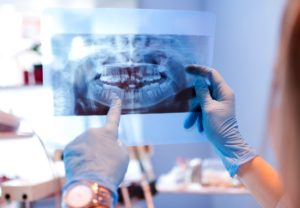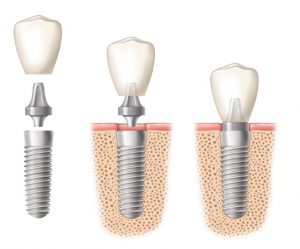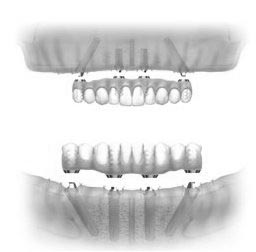Header logo
header top contact widget
All-On-4
Get The Most For Your Investment When Replacing Teeth.
Posted on Jun 12, 2019 by William J. Claiborne, DDS MS
Losing a natural tooth is a big deal. Its loss not only leaves a gap in the appearance of a smile, its absence can lead to movement of surrounding teeth. 
Without all teeth in their proper positions, an open area can cause others to tilt and turn. Additionally, the one above or below will grow longer without having its ‘roommate.’ These issues can lead to broken, fractured, or chipped teeth.
Replacing a tooth involves decisions, and costs. While there are ‘cheap’ ways to replace a tooth, the ideal method – a dental implant – offers lifetime replacement that actually enhances the well-being and lifespan of surrounding teeth.
In dental implant treatment, the ‘implanted’ portion is positioned into the jaw bone as a tooth root replacement. This provides the teeth attached the same foundation as natural tooth roots have. A partial or bridge simply sits on top of gum tissues and relies on adjacent teeth for support.
When a tooth must serve as a support for ‘prosthetic’ teeth, its key role becomes greater. With the added pressure and stress to the natural tooth, there are also more risks to its structure on its own.
Because of the ability to restore the presence of natural teeth to such a great extent, dental implants are the preferred choice for replacement. Although the costs seem greater, over time, the benefits far outweigh the expense. This is why more and more adults are choosing implants to replace one, several, or all missing teeth.
However, there are many factors that can come into play when going forward with a dental implant. Your choice of doctor to place the implanted portion can greatly increase your potential to enjoy your dental implant for a lifetime.
As a Periodontist, my specialty encompasses treatment of all levels of gum disease, the re-contouring of gum tissues, and advanced training in the diagnosis and placement of dental implants. This includes the proper selection of the implant type best for each patient’s needs as well as placement at correct depths and angles.
The most troubling thing I see in implant dentistry is when a patient opted for a “good deal” with a less-experienced doctor, and having to remove a ‘failed’ implant.
Along with an intricate knowledge of the specific type of implant needed, proper placement angles and depth have much to do with the overall success of the implant. For optimal results, the doctor placing the implant should be skilled in the selection of the implant angles and positioning depths.
For example, an implant placed in the upper jaw in too-shallow bone can work its way into the sinus cavity. A lower implant in insufficient bone depth can reach a nerve that runs horizontally through the lower jaw (the mandible).
Additionally, the shape, size and the number of teeth to be attached to an implant have much to do with the type of implant system selected. When the placement doctor is only familiar with one or two types, disasters can occur.
In our Asheville periodontal office, we enjoy restoring the health and appearance of smiles. We also help patients who once struggled with dentures or partials to resume eating the foods they love again and laugh confidently in social gatherings.
The doctor is not the sole factor in success, however, Along with proper selection and placement, a patient must take measures to ensure proper oral hygiene at home. Oral bacteria can contribute to an infection that works its way into the bone surrounding the implant. In some cases, the only way to resolve the infection is to remove the implant.
When a patient entrusts their implant treatment to a skilled doctor and adheres to hygiene and healing guidelines, having an implant fail is very unlikely. The success rate of today’s implant dentistry is excellent – over 97 percent.
If you are considering dental implants, increase your potential for a successful outcome by asking a Periodontist to join your dentist in team treatment. Most general dentists have close relationships with periodontal specialists for implant placement and in treating gum disease.
Feel free to discuss your specific needs and desires before you make your decision. Call (828) 274-9440 to schedule a consultation.
Dental Implants – A Bionic Smile!
Posted on Sep 25, 2018 by William J. Claiborne, DDS MS
Modern medical science is amazing. Today’s technology has helped to advance the ability to provide miraculous solutions to many once-challenging problems. For example, “bionic” arms and hands have been developed to function almost normally. Today, prosthetic legs are moving people out of wheelchairs and into positions to walk and run.
When I think of dental implants, I realize just how miraculous they are as well. While some people think of dental implants as fairly recent on the scene, they have actually been around since the 1950’s. 
Like prosthetic limbs, many types of dental implants have been developed to accommodate specific needs. For example, one known as ‘All-On-4’ is designed for people who have lost a great deal of bone mass. Using a specific design and placement at unique angles, the All-On-Four system overcomes the problems of severe bone loss to support a full arch of non-removable teeth.
Other implant types can support one or a bridge of two or more replacement teeth. Some implant systems are ideal for placement at the time of tooth removal. Still, other systems work in conjunction with additional implants to support multiple teeth.
For individuals who have experienced bone loss (which commonly occurs from years of missing tooth roots), bone grafting can be performed prior to implant placement. Or, bone rebuilding materials can be added to existing bone to rebuild it.
Bone loss is a big deal, even though it’s not always obvious at first. Known as ‘resorption,’ this occurs when tooth roots no longer exist in the jaw bone that once supported natural teeth. Over time, the bone begins to shrink due to lack of stimulation.
Bone loss is the reason that once snug-fitting dentures begin to slip or move while eating. As the ‘ridge’ flattens (which is the gum-covered arch where tooth roots were once held), the foundation that the denture was originally made to conform declines in height. As the bone shrinks, the denture has less and less of a base to support it.
For people who are missing one or several natural teeth, it is paramount that they be replaced, preferably with dental implants. Why? Statistics show that natural teeth adjacent to a lost tooth are at greater risk for being the next to be lost.
Dental implants recreate stimulation to the jaw bone, thereby halting the pace of bone loss. When bone mass is maintained, neighboring teeth have a reduced risk for being lost as well.
Because dental implants are held in the jaw bone, they are also able to restore a natural biting strength with dependable stability. Having the ability to bite and chew efficiently and enjoy a diet of foods you love enhances eating pleasure and proper digestion. It’s no surprise that people who wear dentures have more gastrointestinal problems than those who have their natural teeth.
There are so many advantages to having dental implants. One of the best ones is their longevity. When dental implants are properly selected, placed and maintained, they should last your lifetime. This is why it’s so important to have your implant treatment through a Periodontist.
A periodontal specialist has advanced training and skills in the diagnosis and placement of all types of dental implants. He or she can enhance your ability to enjoy this miraculous tooth replacement option for your lifetime.
If you have lost natural teeth or are facing the potential of tooth removal, call 828-274-9440 to schedule a consultation. This will occur in a private, comfortable consultation room conveniently located in our Asheville office.
During this time, we’ll discuss the implant systems that may work best for your needs and preferences. I’ll explain the treatment involved and sedation options along with estimated treatment fees.
Just as you would want a hand or a leg replaced with a normal looking and functioning prosthetic, you certainly want replacement teeth that function properly and look as natural as the teeth you once had (or better!).
Call today and arrange an appointment to discuss getting your smile back to better-than-ever!
The Makeup Of Dental Implants
Posted on Jul 10, 2017 by William J. Claiborne, DDS MS
Every once in a while, I find it is helpful to explain the components of Dental Implants. Because implant systems come in many different shapes and sizes, understanding the basics can often help an individual determine which is best suited to his or her overall goals.
For example, some people who have worn a denture for years prefer an implant system that has ‘fixed’ teeth attached. This means they will not need to remove the replacement teeth for cleaning.
First, it’s important to understand that a Dental Implant is not the replacement tooth, but a component that serves as the stablizer. The actual implanted portion is positioned into the jaw to serve as a tooth root replacement. This restores a dependable, sturdy foundation that supports teeth that can bite and chew without movement.
In placing the implant portion, an insertion point is made in the gum tissues and the bone underneath where natural tooth roots were once held. Into this, the implant, which is similar to a hollow screw-like cylinder, is placed.
In most cases, the implants are recovered with gum tissue and allowed to bond with surrounding bone for several months. Throughout this period, you can wear your denture or temporary teeth comfortably.
The process of bone growing around the implant is known as ‘osseo-integration.’ During this time, the bone grows around the implant and secures it in place. After several months, the gum tissue is uncovered and a post is secured inside the implant. Onto this post, the final replacement tooth or teeth are attached. These teeth are referred to as crowns or restorations.
One implant can often support a bridge of two or more teeth. Several strategically-placed implants are often used to support a full arch of teeth. For people who have lost a great deal of bone mass, certain implant systems rely on implants that are placed at specific angles to support teeth in minimal bone depth. However, some levels of bone loss need bone rebuilding procedures. These can be performed prior to implant placement and help restore facial appearance as well as overall eating and speaking function.
Because of the wide variety of implant systems, it is important to carefully choose the doctor who will place your implants. A Periodontist has advanced training in the diagnosis and placement of Dental Implants and works closely with other general dentists and dental specialists to help you enjoy a successful outcome.
The type of Dental Implant best suited for your needs can be discussed during a private Consultation. Call (828) 274-9440to arrange a time to discuss the choices that will work best for you.
Different Implant Designs For Different Needs
Posted on May 22, 2017 by William J. Claiborne, DDS MS
As a dental specialist with advanced skills in the diagnosis and placement of Dental Implants, I enjoy staying on top of the latest techniques, technology and materials. Over the years, I have been especially excited to provide our patients with the advancements that make implant dentistry such an ideal option in tooth replacement.
Today’s implant dentistry is successful, safe, dependable and often immediate. As the doctor who places the implants, having a role in restoring a patient’s ability to bite, chew, speak and laugh has been a major highlight in a rewarding career.
One of the reasons for the high success rate of Dental Implants is in the design of different systems. For decades, Implant designs have been fine-tuned so various systems are able to accommodate specific challenges and preferences. In addition to being more affordable than ever, implant systems are now available for nearly every situation, including:
Implants Supporting Non-Removable Teeth – For some, removable teeth attached to implants were too similar to the denture they had (and detested). Even though these removable replacement teeth are firmly secured to the implants, most individuals want teeth that do not come out. However, some of the more affordable systems have been those that support removable teeth. Now, an implant system known as All-On
-4 is able to support non-removable teeth using just 4 strategically-placed implants. By positioning the implanted portions at unique angles, the biting and chewing forces are distributed evenly among fewer implants. Another advantage of this system is its ability to be placed in minimal bone. Long-time denture wearers are often challenged because of severe bone loss. Having insufficient bone mass to support Implants has prevented some people from having implants or required bone rebuilding procedures prior to implant placement. The All-On-4 implant system is able to overcome this obstacle.
Traditional Dental Implants – Still today, the ‘gold standard’ for most implant treatment requires several stages. Placement of the implants is performed first. For several months after, the bone goes through a process known as ‘osseo-integration.’ This takes place over a 3-6 month period and secures the implant in the upper or lower jaw bone, similar to natural tooth roots. Once secured, the implant sites are uncovered and a post is positioned inside to which the replacement teeth are secured. During osseointegration, however, patients are able to comfortably wear their denture or partial.
Fast-Track Dental Implants – As the design of implant systems have advanced with the involvement of computerized technology, implant placement and teeth attachment can often be completed in less time than that required by traditional implants. Having the ability to pre-select ideal placement positions prior means that, in some cases, immediate attachment of teeth can occur. While this option isn’t appropriate for everyone, certain patients are, indeed, excellent candidates. This is why it is important to have an experienced and highly-trained doctor coordinate your diagnosis and placement. When your individual needs are carefully assessed, a successful outcome has greater potential with the foundation of a proper diagnosis and implant selection.
Dental Implants are the closest thing to the natural teeth you once had. They are also designed to last a lifetime, making them an excellent investment. The type of implant system best suited to your needs will be discussed after an examination and review of Panorex (jaw-to-jaw) imaging.
Let’s discuss the implant system that is best for your needs and goals during a private consultation appointment. We’ll also discuss comfort options, including Oral and I.V. Sedation. Call 828-274-9440.
Recent Posts
Categories
Archives
- September 2024
- August 2024
- July 2024
- June 2024
- May 2024
- April 2024
- March 2024
- February 2024
- January 2024
- December 2023
- November 2023
- October 2023
- September 2023
- August 2023
- July 2023
- June 2023
- May 2023
- April 2023
- March 2023
- February 2023
- January 2023
- December 2022
- November 2022
- October 2022
- September 2022
- August 2022
- July 2022
- June 2022
- May 2022
- April 2022
- March 2022
- February 2022
- January 2022
- December 2021
- November 2021
- October 2021
- September 2021
- August 2021
- July 2021
- June 2021
- May 2021
- April 2021
- March 2021
- February 2021
- January 2021
- December 2020
- November 2020
- October 2020
- September 2020
- August 2020
- July 2020
- June 2020
- May 2020
- April 2020
- March 2020
- February 2020
- January 2020
- December 2019
- November 2019
- October 2019
- September 2019
- August 2019
- July 2019
- June 2019
- May 2019
- April 2019
- March 2019
- February 2019
- January 2019
- December 2018
- November 2018
- October 2018
- September 2018
- August 2018
- July 2018
- June 2018
- May 2018
- April 2018
- March 2018
- February 2018
- January 2018
- December 2017
- November 2017
- October 2017
- September 2017
- August 2017
- July 2017
- June 2017
- May 2017
- April 2017
- March 2017
- February 2017
- January 2017
- December 2016
- November 2016
- October 2016
- September 2016
- August 2016
- July 2016
- June 2016
- May 2016
- April 2016
- March 2016
- February 2016
- January 2016
- December 2015
- November 2015
- October 2015
- September 2015
- August 2015
- July 2015
- June 2015
- May 2015
- April 2015
- March 2015
- February 2015
- January 2015
- December 2014
- November 2014
- October 2014
- September 2014
- August 2014
- July 2014
- June 2014
- May 2014
- April 2014
- March 2014
- February 2014
- January 2014
- December 2013
- November 2013
- October 2013
- September 2013
- August 2013
- July 2013
- June 2013
- May 2013
- April 2013
- March 2013
- February 2013
- January 2013
- December 2012
- November 2012
- October 2012
- September 2012
- August 2012
- July 2012
- June 2012



